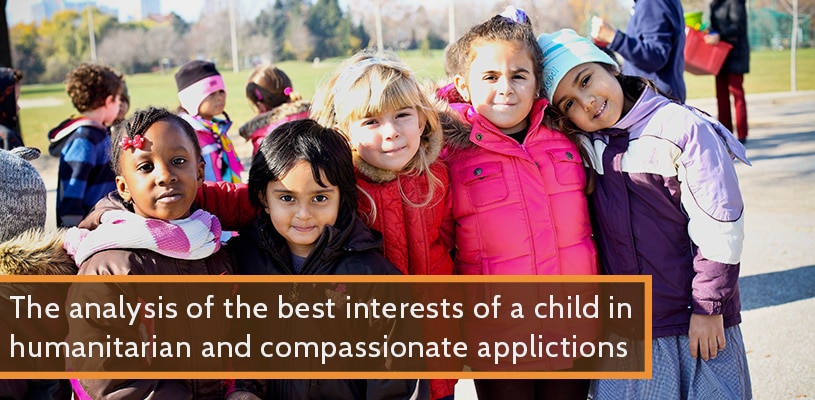Humanitarian and compassionate applications are a type of immigration application for relief from the strict requirements of the law. They are made pursuant to section 25(1) of the Immigration and Refugee Protection Act, which states:
Subject to subsection (1.2), the Minister must, on request of a foreign national in Canada who applies for permanent resident status and who is inadmissible – other than under section 34, 35 or 37 – or who does not meet the requirements of this Act, and may, on request of a foreign national outside Canada – other than a foreign national who is inadmissible under section 34, 35 or 37 – who applies for a permanent resident visa, examine the circumstances concerning the foreign national and may grant the foreign national permanent resident status or an exemption from any applicable criteria or obligations of this Act if the Minister is of the opinion that it is justified by humanitarian and compassionate considerations relating to the foreign national, taking into account the best interests of a child directly affected.
Humanitarian and compassionate applications can be made in a broad range of circumstances where an individual and his or her family are seeking an exemption from some form of inadmissibility under the law. Examples are failed refugee claimants in Canada who would face discrimination in their home country and are seeking legal status to remain, or persons with health conditions or past criminal convictions that would normally render them inadmissible but have some compelling reason to want to enter or remain in the country. Pursuant to s. 25 of the Act, an immigration officer can decide whether the exercise their discretion to waive any requirement of the law if so requested and it is warranted on humanitarian and compassionate grounds considering all the circumstances of the case, which includes considering the best interests of any child affected by the decision.
Recently in Kanthasamy v. Canada (MCI) 2015 SCC 61, the Supreme Court of Canada had an opportunity to review the decision-making practices of the immigration authorities in humanitarian and compassionate applications with a specific focus on the assessment of the best interests of the child. Kanthasamy was a failed refugee claimant from Sri Lanka who was only seventeen years old when he applied for permanent residence on humanitarian and compassionate grounds. The immigration officer who reviewed his application refused it on the basis that Kanthasamy would not face “unusual, undeserved, or disproportionate hardship” if returned to Sri Lanka. This decision was upheld as “reasonable” by both the Federal Court and the Federal Court of Appeal.
In overturning the immigration officer’s decision, the Supreme Court noted that the “unusual, undeserved, or disproportionate hardship” test employed by the immigration officer was not mandated by s. 25 of the Act but was described in a policy guideline manual created by the immigration department for use by immigration officers. The guideline did not have the force of law and was not supposed to be adhered to as though it were law. While it may be a helpful guide, the manual could not be used to fetter the discretion of the officer, who must consider all of the circumstances of the case. The three adjectives “unusual, undeserved, or disproportionate” hardship should be seen as instructive but not determinative, allowing s. 25(1) to respond more flexibly to the equitable goals of the provision.
With regard to the “best interests of the child” analysis required by s. 25 of the Act, the Supreme Court noted that pursuant to the United Nations Convention on the Rights of the Child, all children under the age of 18 were entitled to special consideration. “Children’s interests include such matters as children’s rights, needs, and best interests; maintaining connections between family members; and averting the hardship a person would suffer on being sent to a place where he or she has no connections. The “best interests” principle is highly contextual because of the multitude of factors that may impinge on the child’s best interest. It must therefore be applied in a manner responsive to each child’s particular age, capacity, needs and maturity. The child’s level of development will guide its precise application in the context of a particular case. Protecting children through the “best interests of the child” principle is widely understood and accepted in Canada’s legal system. It means deciding what appears most likely in the circumstances to be conducive to the kind of environment in which a particular child has the best opportunity for receiving the needed care and attention. International human rights instruments to which Canada is a signatory, including the Convention on the Rights of the Child, also stress the centrality of the best interests of a child. Article 3(1) of the Convention in particular confirms the primacy of the best interests principle, stating that: “In all actions concerning children, whether undertaken by public or private social welfare institutions, courts of law, administrative authorities or legislative bodies, the best interests of the child shall be a primary consideration.” A decision under s. 25(1) will therefore be found to be unreasonable if the interests of children affected by the decision are not sufficiently considered. This means that decision-makers must do more than simply state that the interests of a child have been taken into account. Those interests must be well identified and defined and examined with a great deal of attention in light of all the evidence. And since children will rarely, if ever, be deserving of any hardship, the concept of “unusual or undeserved hardship” is presumptively inapplicable to the assessment of the hardship invoked by a child to support his or her application for humanitarian and compassionate relief. Because children may experience greater hardship than adults faced with a comparable situation, circumstances which may not warrant humanitarian and compassionate relief when applied to an adult, may nonetheless entitle a child to relief.”
In Kanthasamy’s case, the Supreme Court found that the immigration officer’s analysis of his best interests was unreasonable. He was 17 at the time of the application and entitled to consideration of his best interests as a child. “The officer failed to give sufficiently serious consideration to his youth, his mental health and the evidence that he would suffer discrimination if he were returned to Sri Lanka. Instead, she took a segmented approach, assessed each factor to see whether it represented hardship that was “unusual and undeserved or disproportionate”, then appeared to discount each from her final conclusion because it failed to satisfy that threshold. Her literal obedience to those adjectives, which do not appear anywhere in s. 25(1), rather than looking at his circumstances as a whole, led her to see each of them as a distinct legal test, rather than as words designed to help reify the equitable purpose of the provision. This had the effect of improperly restricting her discretion and rendering her decision unreasonable.”
The Court also found that the officer’s dismissal of the psychologist’s report was unreasonable and constituted an error. “Having accepted the psychological diagnosis, it is unclear why the Officer would nonetheless have required Kanthasamy to adduce additional evidence about whether he did or did not seek treatment, whether any was even available, or what treatment was or was not available in Sri Lanka. Once the officer accepted that he had post-traumatic stress disorder, adjustment disorder, and depression based on his experiences in Sri Lanka, requiring further evidence of the availability of treatment, either in Canada or in Sri Lanka, undermined the diagnosis and had the problematic effect of making it a conditional rather than a significant factor. And while the Officer did not dispute the psychological report presented, she found that the medical opinion rested mainly on hearsay because the psychologist was not a witness of the events that led to the anxiety experienced by the applicant. This disregarded the unavoidable reality that psychological reports will necessarily be based to some degree of hearsay. Only rarely will a mental health professional personally witness the events for which a patient seeks professional assistance. To suggest that applicants for relief on humanitarian and compassionate grounds may only file expert reports from professionals who have witnessed the facts or events underlying their findings, is unrealistic. In any event, a psychologist need not be an expert on country conditions in a particular country to provide expert information about the probable psychological effect of removal from Canada.”
The Court also embarked on a lengthy analysis of the officer’s finding that Kanthasamy would not be subject to discrimination as a Tamil in Sri Lanka. The Court stated that the factual findings of the Refugee Board in Kanthasamy’s case could be relied upon for purposes of a discrimination analysis. The officer erred by finding that since Kanthasamy had not been subject to direct acts of discrimination that there was no evidence of discrimination. “Applicants need only show that they would likely be affected by adverse conditions such as discrimination. Evidence of discrimination experienced by others who share the applicant’s identity is therefore clearly relevant under s. 25(1), whether or not the applicant has evidence of being personally targeted, and reasonable inferences can be drawn from those experiences.”
Returning to the best interests of the child analysis, the Supreme Court found that the officer’s analysis of Kanthasamy’s best interests “was perfunctory and failed to accord the serious weight and consideration essential to a proper appreciation of a child’s best interests. At no point did the Officer appear to turn her mind to how his status as a child affected the evaluation of the other evidence raised in his application. Instead, she atomized her evaluation of each of the other elements of his application, referring to his status as a child only in isolation. Nowhere did the Officer ask whether the effect of separating Kanthasamy from the people he was close to in Canada would be magnified by the fact that his relationships with them developed when he was a teenager. This approach was inconsistent with how hardship should be uniquely addressed for children. Moreover, by evaluating Kanthasamy’s best interests through the same literal approach she applied to each of his other circumstances — whether the hardship was “unusual and undeserved or disproportionate” — she misconstrued the best interests of the child analysis, most crucially disregarding the guiding admonition that children will rarely, if ever, be deserving of any hardship.”
The Court therefore allowed the appeal, with costs to Kanthasamy. The decision was a 5-2 split, with McLachlin C.J. , Abella J. (who rendered the decision), Cromwell J., Karakatsanis J. and Gascon J. ruling in Kanthasamy’s favour, and with Moldover J and Wagner J dissenting.
Kanthasamy is without doubt the most important decision related to the assessment of humanitarian and compassionate applications since Baker v. Canada (MCI) [1999] 2 SCR 817. As such it is welcome to immigration practitioners and assists in resolving long-standing debates within the jurisprudence on several issues. Especially welcome is the fact that the Supreme Court has extended rather than restricted the scope of humanitarian and compassionate applications, which are an essential tool to mitigating the sometimes harsh restrictions of Canada’s immigration legislation.























